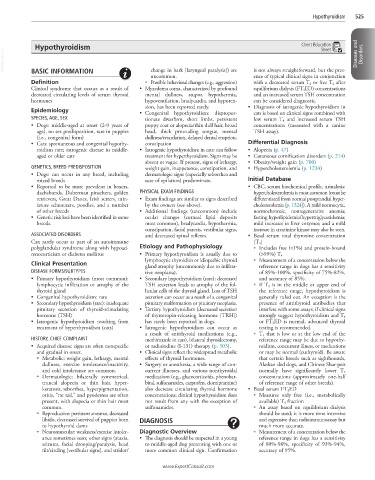Page 1062 - Cote clinical veterinary advisor dogs and cats 4th
P. 1062
Hypothyroidism 525
Hypothyroidism Client Education
Sheet
VetBooks.ir Diseases and Disorders
change in bark [laryngeal paralysis]) are
BASIC INFORMATION
ence of typical clinical signs in conjunction
uncommon. is not always straightforward, but the pres-
Definition ○ Possible behavioral changes (e.g., aggression) with a decreased serum T 4 or free T 4 after
Clinical syndrome that occurs as a result of • Myxedema coma, characterized by profound equilibrium dialysis (FT 4 ED) concentrations
decreased circulating levels of serum thyroid mental dullness, stupor, hypothermia, and an increased serum TSH concentration
hormones hypoventilation, bradycardia, and hypoten- can be considered diagnostic.
sion, has been reported rarely. • Diagnosis of iatrogenic hypothyroidism in
Epidemiology • Congenital hypothyroidism: dispropor- cats is based on clinical signs combined with
SPECIES, AGE, SEX tionate dwarfism, short limbs, persistent low serum T 4 and increased serum TSH
• Dogs: middle-aged at onset (2-9 years of puppy coat or alopecia/thin dull hair, broad concentrations (measured with a canine
age), no sex predisposition, rare in puppies head, thick protruding tongue, mental TSH assay).
(i.e., congenital form) dullness/retardation, delayed dental eruption,
• Cats: spontaneous and congenital hypothy- constipation Differential Diagnosis
roidism rare; iatrogenic disease in middle- • Iatrogenic hypothyroidism in cats: can follow • Alopecia (p. 47)
aged or older cats treatment for hyperthyroidism. Signs may be • Cutaneous cornification disorders (p. 214)
absent or vague. If present, signs of lethargy, • Obesity/weight gain (p. 700)
GENETICS, BREED PREDISPOSITION weight gain, inappetence, constipation, and • Hypercholesterolemia (p. 1234)
• Dogs: can occur in any breed, including dermatologic signs (especially seborrhea and
mixed breeds ease of epilation) predominate. Initial Database
• Reported to be more prevalent in boxers, • CBC, serum biochemical profile, urinalysis:
dachshunds, Doberman pinschers, golden PHYSICAL EXAM FINDINGS hypercholesterolemia is most common (must be
retrievers, Great Danes, Irish setters, min- • Exam findings are similar to signs described differentiated from normal postprandial hyper-
iature schnauzers, poodles, and a number by the owners (see above). cholesterolemia [p. 1324]). A mild normocytic,
of other breeds • Additional findings (uncommon) include normochromic, nonregenerative anemia;
• Genetic risk loci have been identified in some ocular changes (corneal lipid deposits fasting hyperlipidemia/hypertriglyceridemia;
breeds. most common), bradycardia, hypothermia, mild increases in liver enzymes; and a mild
constipation, facial paresis, vestibular signs, increase in creatinine kinase may also be seen.
ASSOCIATED DISORDERS and decreased spinal reflexes. • Basal serum total thyroxine concentration
Can rarely occur as part of an autoimmune [T 4 ]
polyglandular syndrome along with hypoad- Etiology and Pathophysiology ○ Includes free (<1%) and protein-bound
renocorticism or diabetes mellitus • Primary hypothyroidism is usually due to (>99%) T 4
lymphocytic thyroiditis or idiopathic thyroid ○ Measurement of a concentration below the
Clinical Presentation gland atrophy (uncommonly due to infiltra- reference range in dogs has a sensitivity
DISEASE FORMS/SUBTYPES tive neoplasia). of 89%-100%, specificity of 75%-82%,
• Primary hypothyroidism (most common): • Secondary hypothyroidism (rare): decreased and accuracy of 85%.
lymphocytic infiltration or atrophy of the TSH secretion leads to atrophy of the fol- ○ If T 4 is in the middle or upper end of
thyroid gland licular cells of the thyroid gland. Loss of TSH the reference range, hypothyroidism is
• Congenital hypothyroidism: rare secretion can occur as a result of a congenital generally ruled out. An exception is the
• Secondary hypothyroidism (rare): inadequate pituitary malformation or pituitary neoplasia. presence of antithyroid antibodies that
pituitary secretion of thyroid-stimulating • Tertiary hypothyroidism (decreased secretion interfere with some assays; if clinical signs
hormone (TSH) of thyrotropin-releasing hormone [TRH]) strongly suggest hypothyroidism and T 4
• Iatrogenic hypothyroidism resulting from has rarely been reported in dogs. or FT 4ED is normal, advanced thyroid
treatment of hyperthyroidism (cats) • Iatrogenic hypothyroidism can occur as testing is recommended.
a result of antithyroid medications (e.g., ○ T 4 that is low or at the low end of the
HISTORY, CHIEF COMPLAINT methimazole in cats), bilateral thyroidectomy, reference range may be due to hypothy-
• Acquired disease: signs are often nonspecific or radioiodine (I-131) therapy (p. 503). roidism, concurrent illness, or medications
and gradual in onset. • Clinical signs reflect the widespread metabolic or may be normal (euthyroid). Be aware
○ Metabolic: weight gain, lethargy, mental effects of thyroid hormones. that certain breeds such as sighthounds,
dullness, exercise intolerance/inactivity, • Surgery or anesthesia, a wide range of con- Alaskan sled dogs, and Chinese Shar-peis
and cold intolerance are common. current illnesses, and various nonthyroidal normally have significantly lower T 4
○ Dermatologic: bilaterally symmetrical, medications (e.g., glucocorticoids, phenobar- concentrations (approximately one-half
truncal alopecia or thin hair, hyper- bital, sulfonamides, carprofen, clomipramine) of reference range of other breeds).
keratosis, seborrhea, hyperpigmentation, also decrease circulating thyroid hormone • Basal serum FT 4 ED
otitis, “rat tail,” and pyoderma are often concentrations; clinical hypothyroidism does ○ Measures only free (i.e., metabolically
present, with alopecia or thin hair most not result from any with the exception of available) T 4 fraction
common. sulfonamides. ○ An assay based on equilibrium dialysis
○ Reproductive: persistent anestrus, decreased should be used; it is more time intensive
libido, decreased survival of puppies born DIAGNOSIS and expensive than radioimmunoassay but
to hypothyroid dams much more accurate.
○ Neuromuscular: weakness/exercise intoler- Diagnostic Overview ○ Measurement of a concentration below the
ance sometimes seen; other signs (ataxia, • The diagnosis should be suspected in a young reference range in dogs has a sensitivity
seizures, facial drooping/paralysis, head to middle-aged dog presenting with one or of 80%-98%, specificity of 93%-94%,
tilt/circling [vestibular signs], and stridor/ more common clinical sign. Confirmation accuracy of 95%.
www.ExpertConsult.com

